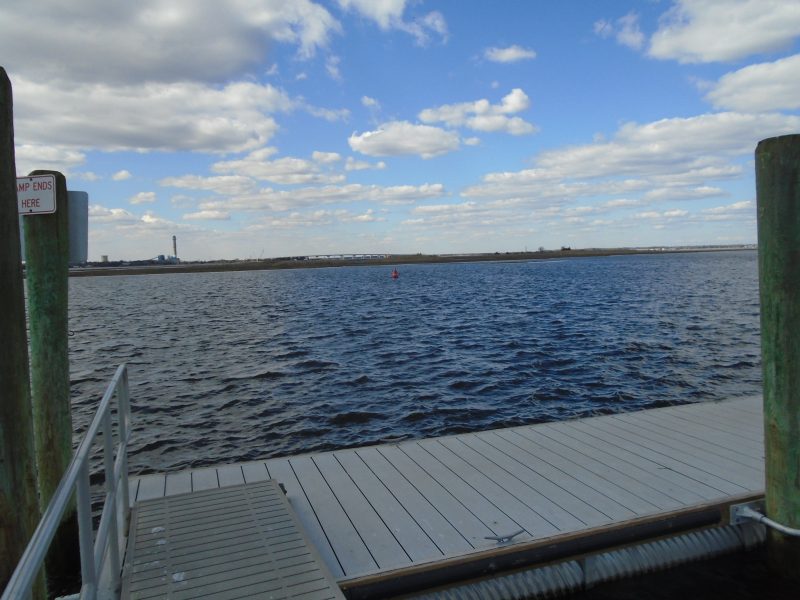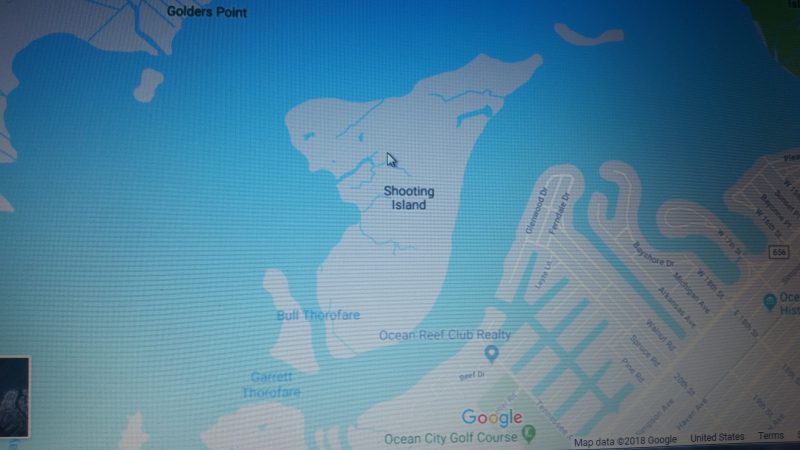The restoration of Poplar Island in the Chesapeake Bay off Maryland is seen as a model for rebuilding the wetlands at Shooting Island. (Courtesy U.S. Army Corps of Engineers)
 By Donald Wittkowski
Think of it as Ocean City’s little brother – a 133-acre island sitting in the middle of the back bay, just across a narrow channel.
Shooting Island, as it is known, is an uninhabited flat land mass under threat from erosion. Among other places, it is visible from Ocean City by peering out over the bay from the public boat ramp at the end of Tennessee Avenue.
Shooting Island is now a topic of conversation between Ocean City officials and the New Jersey Department of Environmental Protection’s Division of Fish and Wildlife. They are discussing plans to help rebuild the island’s eroded wetlands by possibly using sediment dredged from the back bays as an environmentally-friendly material.
“Part of the idea is to restore the historic size and profile of the island. It’s getting smaller all the time,” city spokesman Doug Bergen said.
The benefits of the project would be twofold: The island’s fragile wetlands would be restored, while Ocean City would gain another disposal site for material taken out of the shallow back bays during its extensive, multiyear dredging program, officials said.
In the process, the rebuilt wetlands at Shooting Island would create a stronger natural barrier to help protect Ocean City during coastal storms, City Business Administrator Jim Mallon explained.
“The rebuilding of the island, and healthy wetlands on the island, are not only important ecological features, but also important storm-resiliency measures for the bayfront in our hometown,” Mallon told members of City Council during their March 22 meeting.
In a first step, Council approved a resolution authorizing the city to apply to the DEP’s Division of Fish and Wildlife for regulatory permits to use Shooting Island as a disposal site for dredge material, Bergen said.
Bergen stressed that the plan is only in the preliminary stages. It is not yet clear how long it will take the Division of Fish and Wildlife to issue the permits, if it even approves of the project.
“All this does is let us pay for the permits, so it’s starting the process to do this,” Bergen said.
By Donald Wittkowski
Think of it as Ocean City’s little brother – a 133-acre island sitting in the middle of the back bay, just across a narrow channel.
Shooting Island, as it is known, is an uninhabited flat land mass under threat from erosion. Among other places, it is visible from Ocean City by peering out over the bay from the public boat ramp at the end of Tennessee Avenue.
Shooting Island is now a topic of conversation between Ocean City officials and the New Jersey Department of Environmental Protection’s Division of Fish and Wildlife. They are discussing plans to help rebuild the island’s eroded wetlands by possibly using sediment dredged from the back bays as an environmentally-friendly material.
“Part of the idea is to restore the historic size and profile of the island. It’s getting smaller all the time,” city spokesman Doug Bergen said.
The benefits of the project would be twofold: The island’s fragile wetlands would be restored, while Ocean City would gain another disposal site for material taken out of the shallow back bays during its extensive, multiyear dredging program, officials said.
In the process, the rebuilt wetlands at Shooting Island would create a stronger natural barrier to help protect Ocean City during coastal storms, City Business Administrator Jim Mallon explained.
“The rebuilding of the island, and healthy wetlands on the island, are not only important ecological features, but also important storm-resiliency measures for the bayfront in our hometown,” Mallon told members of City Council during their March 22 meeting.
In a first step, Council approved a resolution authorizing the city to apply to the DEP’s Division of Fish and Wildlife for regulatory permits to use Shooting Island as a disposal site for dredge material, Bergen said.
Bergen stressed that the plan is only in the preliminary stages. It is not yet clear how long it will take the Division of Fish and Wildlife to issue the permits, if it even approves of the project.
“All this does is let us pay for the permits, so it’s starting the process to do this,” Bergen said.
 An image taken from Google Maps shows the location of Shooting Island in the back bay off Ocean City.
An image taken from Google Maps shows the location of Shooting Island in the back bay off Ocean City.
 The restoration of Poplar Island in the Chesapeake Bay off Maryland is seen as a model for rebuilding the eroded wetlands at Shooting Island. (Courtesy U.S. Army Corps of Engineers)
Ocean City officials are pointing to an acclaimed restoration project in the Chesapeake Bay as proof that dredge material can be successfully used to help rebuild islands.
Poplar Island, in the Chesapeake Bay off Maryland, spanned more than 1,100 acres in the mid-1800s, but shrank to a mere five acres by the 1990s due to erosion caused by waves, winds and tidal currents.
Now, Poplar Island is being rebuilt by the U.S. Army Corps of Engineers using material dredged from the approach channels to the Chesapeake Bay. The project was hailed as a “man-made miracle” in a 2015 story in the Washington Post.
According to the Washington Post, a plan was approved to safely dump soil dredged from the bay on Poplar Island without interfering with the wildlife and delicate eco-system.
Mallon and Bergen, accompanied by representatives of ACT Engineers, Ocean City’s dredging consultant, visited Poplar Island in the fall to see how the restoration project there might serve as a model for Shooting Island.
“In partnership with the Division of Fish and Wildlife, Ocean City will work to re-establish healthy wetlands on this island,” Mallon said of Shooting Island. “This type of program has been successful in other parts of the country, including Poplar Island in the Chesapeake.”
The restoration of Poplar Island in the Chesapeake Bay off Maryland is seen as a model for rebuilding the eroded wetlands at Shooting Island. (Courtesy U.S. Army Corps of Engineers)
Ocean City officials are pointing to an acclaimed restoration project in the Chesapeake Bay as proof that dredge material can be successfully used to help rebuild islands.
Poplar Island, in the Chesapeake Bay off Maryland, spanned more than 1,100 acres in the mid-1800s, but shrank to a mere five acres by the 1990s due to erosion caused by waves, winds and tidal currents.
Now, Poplar Island is being rebuilt by the U.S. Army Corps of Engineers using material dredged from the approach channels to the Chesapeake Bay. The project was hailed as a “man-made miracle” in a 2015 story in the Washington Post.
According to the Washington Post, a plan was approved to safely dump soil dredged from the bay on Poplar Island without interfering with the wildlife and delicate eco-system.
Mallon and Bergen, accompanied by representatives of ACT Engineers, Ocean City’s dredging consultant, visited Poplar Island in the fall to see how the restoration project there might serve as a model for Shooting Island.
“In partnership with the Division of Fish and Wildlife, Ocean City will work to re-establish healthy wetlands on this island,” Mallon said of Shooting Island. “This type of program has been successful in other parts of the country, including Poplar Island in the Chesapeake.”